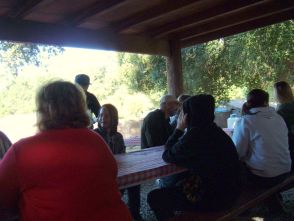Consider: When do you see the body, building, and bride images in your local congregation?
Church as Body
Church as Building
Church as Bride
 As church, are we a gathering of like-minded Christians? Are we a social club? Are we a service organization? While some of our activities are similar to affinity groups, social clubs, and service organizations, we are none of these things. Being church is something very different that these three groups.
As church, are we a gathering of like-minded Christians? Are we a social club? Are we a service organization? While some of our activities are similar to affinity groups, social clubs, and service organizations, we are none of these things. Being church is something very different that these three groups.
Using the three images of body, building, and bride, the Apostle Paul fleshes out the connection, participation, and process inherent in being Church. Connection with God and fellow believers provides the support needed for the struggle under the sun (Ecclesiastes; John 16:29-33). Participation with Christ and fellow believers in the growth of the body means we are not mere pawns in the struggle with spiritual powers. As a people in process, we have hope for the future and comfort in present setbacks. The Church has not yet arrived AND she is safe.
How do these images support Paul’s argument in his letter to the Ephesians? These images show that the essential connection with Christ is both the source and goal of the church’s life. There is no need to fear or rely upon the spiritual powers. These images show that this essential connection is the ground upon which believers can stand as they live in and respond to a culture permeated with concern for spiritual power.
Theological Considerations
Everything the church is flows from and toward her connection with Christ. As his body, the church is his presence in the world. The church does the will of her head (Jesus) and draws upon his power as she works in the world for his sake. As his body, she is the one new humanity, created and growing into the image of Christ, demonstrating God’s wisdom to the powers (3:10).
As God’s building, the church is and is becoming the dwelling place of God. Christ himself is the origin of the building, the source of power for the process of building, and the goal toward which the building grows. The church finds her shape in Christ, the chief corner stone. She is founded upon the teaching of his apostles and prophets. She is supplied with gifts and equippers that support the building process.
As bride, the church submits to and is loved by her husband, the Christ. She willingly submits to him by choosing to be and to do for his good. Christ loves the church by choosing to be and to do for her good.
Practical Implications
Questions on the nature of church need to be asked within and among the Christian traditions. A theology of church drawn from the images in Paul’s letter to the Ephesians can provide an important foundation from which to seek answers.
There are several key understandings.
The church is one. Human divisions are just that—human. There are real theological issues to be discussed, but there is also a real unity. We must find a way to remain committed to our beliefs while holding passionately to one another.
The church is in the process of maturing. We will not be complete until the consummation in the last day. Because we are incomplete, we must listen to the voices of our brothers and sisters. We must consider their questions. We must all do our part.
The church is built on the foundation of the apostles and prophets. Experience is important. The writings of our theological mothers and fathers are important. But an intimate understanding of God’s Word is essential: we must start there.
The church is intimately connected to Christ. This is our current reality, though our experience of it is incomplete. Everything the church is and everything she is to become exists in and grows toward her relationship with Christ.
Add your voice: When do you see the body, building, and bride images in your local congregation?
Originally published as Body-Building-Bride: Introduction on March 13, 2006

